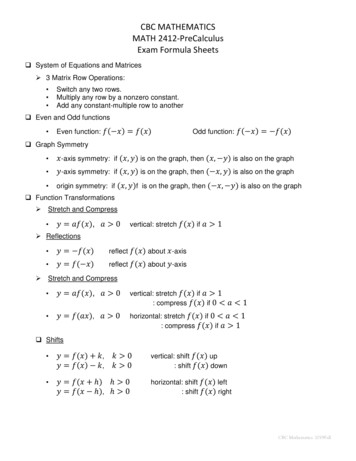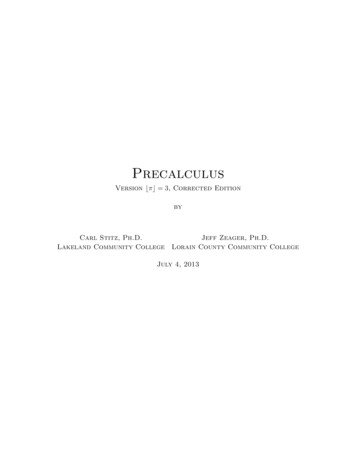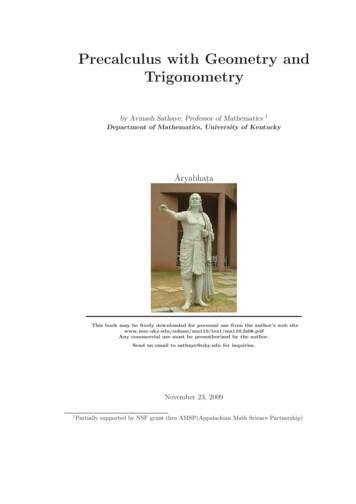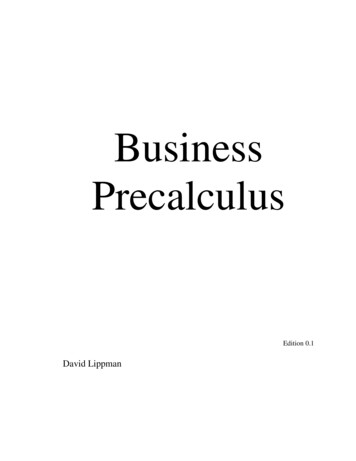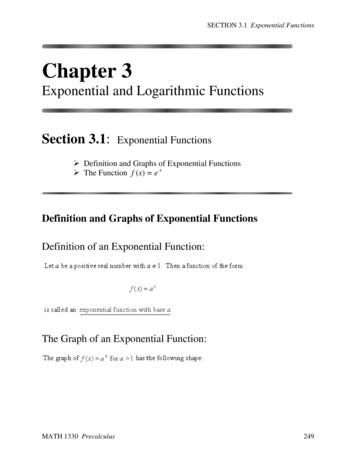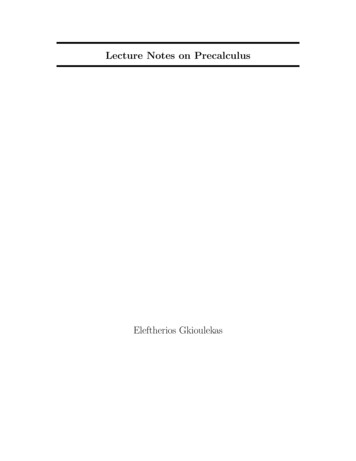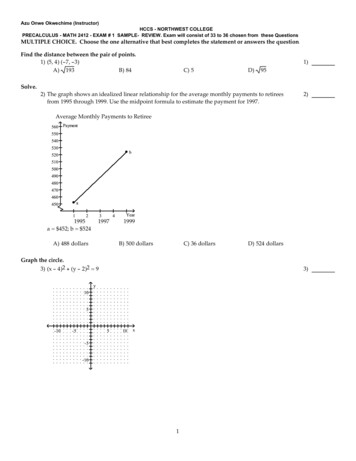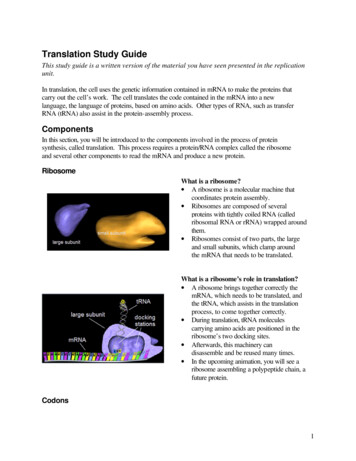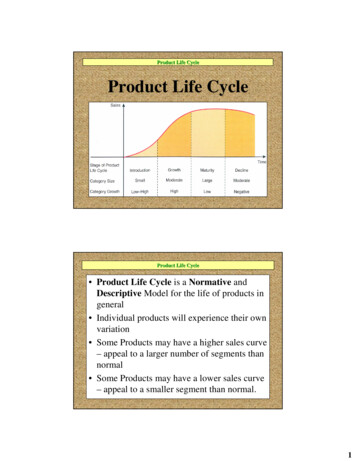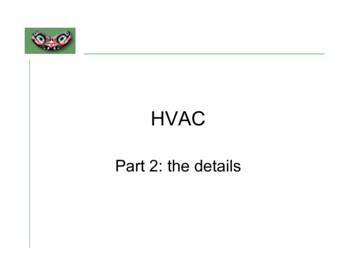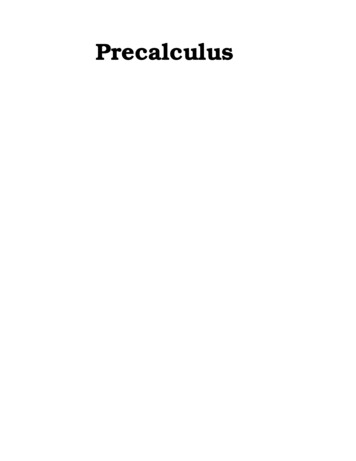
Transcription
Precalculus
PrecalculusDavid H. CollingwoodDepartment of MathematicsUniversity of WashingtonK. David PrinceMinority Science and Engineering ProgramCollege of EngineeringUniversity of WashingtonMatthew M. ConroyDepartment of MathematicsUniversity of WashingtonSeptember 2, 2011
iiCopyright c 2003 David H. Collingwood and K. David Prince. Copyright c 2011David H. Collingwood, K. David Prince, and Matthew M. Conroy. Permission isgranted to copy, distribute and/or modify this document under the terms of theGNU Free Documentation License, Version 1.1 or any later version published bythe Free Software Foundation; with no Invariant Sections, with no Front-Cover,and with no Back-Cover Texts. A copy of the license is included in the sectionentitled “GNU Free Documentation License”.
Author NoteFor most of you, this course will be unlike any mathematics course youhave previously encountered. Why is this?Learning a new languageColleges and universities have been designed to help us discover, shareand apply knowledge. As a student, the preparation required to carry outthis three part mission varies widely, depending upon the chosen field ofstudy. One fundamental prerequisite is fluency in a “basic language”;this provides a common framework in which to exchange ideas, carefully formulate problems and actively work toward their solutions. Inmodern science and engineering, college mathematics has become this“basic language”, beginning with precalculus, moving into calculus andprogressing into more advanced courses. The difficulty is that collegemathematics will involve genuinely new ideas and the mystery of thisunknown can be sort of intimidating. However, everyone in this coursehas the intelligence to succeed!Is this course the same as high school Precalculus?There are key differences between the way teaching and learning takesplace in high schools and universities. Our goal is much more than justgetting you to reproduce what was done in the classroom. Here are somekey points to keep in mind: The pace of this course will be faster than a high school class inprecalculus. Above that, we aim for greater command of the material, especially the ability to extend what we have learned to newsituations. This course aims to help you build the stamina required to solvechallenging and lengthy multi-step problems. As a rule of thumb, this course should on average take 15 hoursof effort per week. That means that in addition to the 5 classroomhours per week, you would spend 10 hours extra on the class. Thisis only an average and my experience has shown that 12–15 hoursiii
ivof study per week (outside class) is a more typical estimate. In otherwords, for many students, this course is the equivalent of a halftime job! Because the course material is developed in a highly cumulativemanner, we recommend that your study time be spread out evenlyover the week, rather than in huge isolated blocks. An analogy withathletics is useful: If you are preparing to run a marathon, you musttrain daily; if you want to improve your time, you must continuallypush your comfort zone.PrerequisitesThis course assumes prior exposure to the “mathematics” in Chapters1-12; these chapters cover functions, their graphs and some basic examples. This material is fully developed, in case you need to brush up on aparticular topic. If you have never encountered the concept of a function,graphs of functions, linear functions or quadratic functions, this coursewill probably seem too advanced. You are not assumed to have takena course which focuses on mathematical problem solving or multi-stepproblem solving; that is the purpose of this course.InternetThere is a great deal of archived information specific to this course thatcan be accessed via the World Wide Web at the URL addresshttp://www.math.washington.edu/ m120Why are we using this text?Prior to 1990, the performance of a student in precalculus at the University of Washington was not a predictor of success in calculus. For thisreason, the mathematics department set out to create a new course witha specific set of goals in mind: A review of the essential mathematics needed to succeed in calculus. An emphasis on problem solving, the idea being to gain both experience and confidence in working with a particular set of mathematical tools.This text was created to achieve these goals and the 2004-05 academicyear marks the eleventh year in which it has been used. Several thousand students have successfully passed through the course.
vNotation, Answers, etc.This book is full of worked out examples. We use the the notation “Solution.” to indicate where the reasoning for a problem begins; the symbol is used to indicate the end of the solution to a problem. There is a Tableof Contents that is useful in helping you find a topic treated earlier inthe course. It is also a good rough outline when it comes time to studyfor the final examination. The book also includes an index at the end.Finally, there is an appendix at the end of the text with ”answers” to mostof the problems in the text. It should be emphasized these are ”answers”as opposed to ”solutions”. Any homework problems you may be asked toturn in will require you include all your work; in other words, a detailedsolution. Simply writing down the answer from the back of the text wouldnever be sufficient; the answers are intended to be a guide to help insureyou are on the right track.How to succeed in Math 120.Most people learn mathematics by doing mathematics. That is, you learnit by active participation; it is very unusual for someone to learn the material by simply watching their instructor perform on Monday, Wednesday, and Friday. For this reason, the homework is THE heart of thecourse and more than anything else, study time is the key to successin Math 120. We advise 15 hours of study per week, outside class.Also, during the first week, the number of study hours will probably beeven higher as you adjust to the viewpoint of the course and brush upon algebra skills.Here are some suggestions: Prior to a given class, make sure you havelooked over the reading assigned. If you can’t finish it, at least look it overand get some idea of the topic to be discussed. Having looked over thematerial ahead of time, you will get FAR MORE out of the lecture. Then,after lecture, you will be ready to launch into the homework. If you followthis model, it will minimize the number of times you leave class in a daze.In addition, spread your study time out evenly over the week, rather thanwaiting until the day before an assignment is due.AcknowledgmentsThe efforts of numerous people have led to many changes, correctionsand improvements. We want to specifically thank Laura Acuña, PatrickAverbeck, Jim Baxter, Sandi Bennett, Daniel Bjorkegren, Cindy Burton,Michael D. Calac, Roll Jean Cheng, Jerry Folland, Dan Fox, Grant Galbraith, Peter Garfield, Richard J. Golob, Joel Grus, Fred Kuczmarski,Julie Harris, Michael Harrison, Teri Hughes, Ron Irving, Ian Jannetty,Mark Johnson, Michael Keynes, Andrew Loveless, Don Marshall, Linda
viMartin, Alexandra Nichifor, Patrick Perkins, Lisa Peterson, Ken Plochinski, Eric Rimbey, Tim Roberts, Aaron Schlafly, David Schneider, MarilynStor, Lukas Svec, Sarah Swearinger, Jennifer Taggart, Steve Tanner, PaulTseng, and Rebecca Tyson. I am grateful to everyone for their hard workand dedication to making this a better product for our students.The Minority Science and Engineering Program (MSEP) of the College of Engineering supports the development of this textbook. It is alsoauthoring additional materials, namely, a student study guide and aninstructor guide. MSEP actively uses these all of these materials in itssummer mathematics program for freshman pre-engineers. We want tothank MSEP for its contributions to this textbook.We want to thank Intel Corporation for their grant giving us an ”Innovation in Education” server donation. This computer hardware was usedto maintain and develop this textbook.CommentsSend comments, corrections, and ideas to colling@math.washington.eduor kdp@engr.washington.edu.
PrefaceHave you ever noticed this peculiar feature of mathematics: When youdon’t know what is going on, it is really hard, difficult, and frustrating.But, when you know what is going on, mathematics seems incrediblyeasy, and you wonder why you had trouble with it in the first place!Here is another feature of learning mathematics: When you are struggling with a mathematical problem, there are times when the answerseems to pop out at you. At first, nothing is there, then very suddenly,in a flash, the answer is all there, and you sit wondering why you didn’t“see” the solution sooner. We have a special name for this: It’s the “AHa!” experience. Often the difficulty you have in studying mathematicsis that the rate at which you are having an A-Ha! experience might be solow that you get discouraged or, even worse, you give up studying mathematics altogether. One purpose of this course is to introduce you tosome strategies that can help you increase the rate of your mathematicalA-Ha! experiences.What is a story problem?When we ask students if they like story problems, more often than not,we hear statements like: “I hate story problems!” So, what is it aboutthese kinds of problems that causes such a negative reaction? Well,the first thing you can say about story problems is that they are mostlymade up of words. This means you have to make a big effort to readand understand the words of the problem. If you don’t like to read, storyproblems will be troublesome.The second thing that stands out with story problems is that theyforce you to think about how things work. You have to give deep thoughtto how things in the problem relate to each other. This in turn means thatstory problems force you to connect many steps in the solution process.You are no longer given a list of formulas to work using memorized steps.So, in the end, the story problem is a multi-step process such that the“A-Ha!” comes only after lots of intense effort.All of this means you have to spend time working on story problems.It is impossible to sit down and spend only a minute or two workingeach problem. With story problems, you have to spend much more timeworking toward a solution, and at the university, it is common to spendvii
viiian hour or more working each problem. So another aspect of workingthese kinds of problems is that they demand a lot of work from you, theproblem solver.We can conclude this: What works is work! Unfortunately, there isno easy way to solve all story problems. There are, however, techniquesthat you can use to help you work efficiently. In this course, you willbe presented with a wide range of mathematical tools, techniques, andstrategies that will prepare you for university level problem solving.What are the BIG errors?Before we look at how to make your problem solving more efficient, let’slook at some typical situations that make problem solving inefficient. Ifyou want to be ready for university level mathematics, we are sure youhave heard somewhere: “You must be prepared!” This means you needto have certain well-developed mathematical skills before you reach theuniversity. We would like to share with you the three major sources oferrors students make when working problems, especially when they areworking exam problems. Every time we sit down and review solutionswith a student who has just taken an exam, and who has lost a lot ofpoints in that exam, we find errors falling pretty much into three categories, and these errors are the major cause of inefficient mathematicalproblem solving.The first type of error that loses points is algebra. This is an error ofnot knowing all of the algebraic rules. This type of error also includesmistakes in the selection and use of mathematical symbols. Often, during the problem solving process, you are required to introduce mathematical symbols. But, without these symbols, you cannot make anyfurther progress. Think of it this way: Without symbols, you cannot doany mathematics involving equations!The second error we see in problem solving has to do with visualization. In this case, we’re talking about more than the graphics you canget from a calculator. Graphing and curve sketching are very importantskills. But, in doing story problems, you might find it almost impossible to create a solution without first drawing a picture 1 of your problem.Thus, by not drawing a good picture of the problem, students get stuckin their exams, often missing the solution to a problem entirely.Finally, the third big source of error is not knowing mathematical definitions. Actually, this is a huge topic, so we will only touch on some ofthe main features of this kind of error. The key thing here is that by notknowing mathematical definitions, it becomes very hard to know what todo next in a multi-step solution to a story problem.1Whenever we talk about a picture of your problem, we mean not just the drawingitself. In this case, the picture must include the drawing and the labels which clearlysignify the quantities related to your problem.
ixHere is what it all boils down to: Mathematical definitions, for themost part, provide little cookbook procedures for computing or measuringsomething. For example, if you did not know the mathematical definitionof “speed,” you would not know that to measure speed, you first measureyour distance and you simultaneously measure the time it takes to coverthat distance. Notice this means you have two measuring instrumentsworking at the same time. The second thing you must do, according tothe definition of speed, is divide the distance you measured by the timeyou measured. The result of your division is a number that you will callspeed. The definition is a step-by-step procedure that everyone agreesto when talking about “speed.” So, it’s easy to understand that if youare trying to solve a story problem requiring a speed computat
Prior to 1990, the performance of a student in precalculus at the Univer-sity of Washington was not a predictor of success in calculus. For this reason, the mathematics department set out to create a new course with a specific set of goals in mind: A review of the essential mathematicsneeded to succeed in calculus. An emphasis on problem solving, the idea being to gain both experi .
